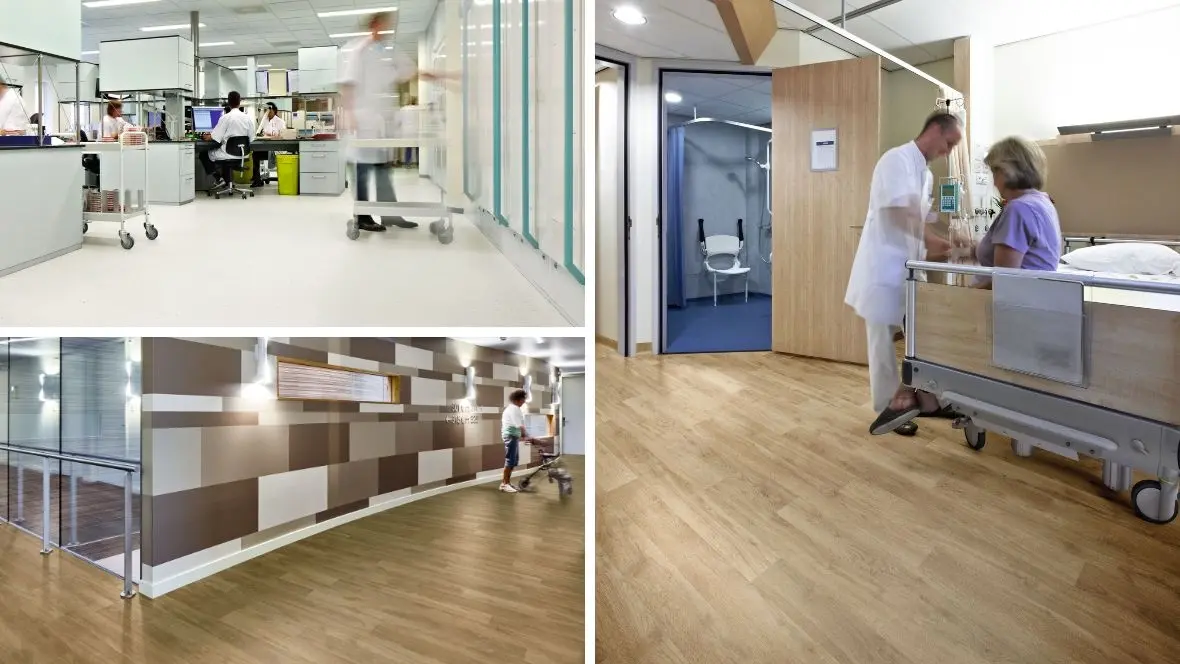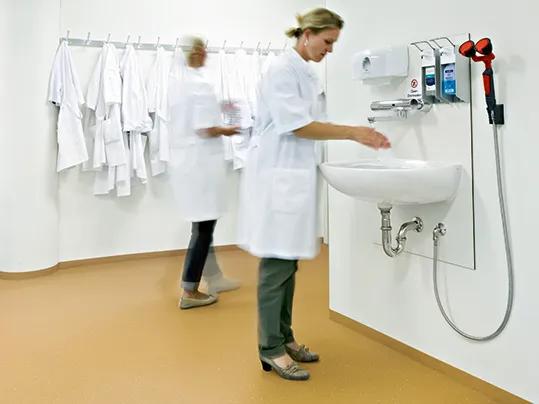Correctly Choosing Safety Flooring
Focus on Healthcare
Craig Thornhill, Technical Services Manager

Craig Thornhill, Technical Services Manager at Forbo Flooring Systems explores the factors to consider when specifying safety flooring for healthcare environments, to ensure the solutions chosen are fit for purpose to protect patients, visitors and staff from accidental slips and trips.
In the three months before May 2022, an average of 45,000 people went to major A&E departments in England every day, which averages to 16 million attendances throughout the year (Source: Research briefing. With this in mind, it’s important to keep all those recovering, visiting or working in a hospital safe from hazards, such as slips and trips.
In fact, with hospitals being very busy places, the floors are exposed to all types of contaminants. As such, maintaining a high level of slip resistance is key to patient and staff safety – and this is where specifying appropriately graded slip resistant flooring (safety floor), can make a significant difference.
When looking at specifying safety flooring, it can be useful to understand the testing methods used to grade the products, to help you to identify the correct solution.

First up is the Pendulum Test, recommended by the Health and Safety Executive (HSE) to assess the slip resistance of floor surfaces. A pendulum test is conducted by a swinging arm that sweeps over a flooring surface. One side of this arm is a rubber slider, which strikes and passes along the floor from a predetermined distance. Once the arm strikes the floor, friction will cause it to slow down and it will therefore, not swing as far. Where the arm finishes following the swing will indicate a value with a pointer and this is your pendulum test value (PTV).
The test can assess slip resistance in both dry and contaminated conditions and measures the coefficient of friction of a floor surface to provide a slip potential classification. The UK Slip Resistance Group and HSE guidelines demonstrate that a PTV of zero to 24 indicates high slip potential, a PTV of 24 to 35 signifies moderate slip potential, and a PTV of 36 or higher is classified as low slip risk.
There is also the ‘Ramp Test’, mainly referred to as the R rating. The way this test is conducted is by strapping a test subject – who is linked up to a safety harness – onto a ramp, which is lubricated with oil. The angle of the ramp is then raised, and the tester will take small steps backwards and forwards in boots until they slip. A computerised readout will determine the R rating based on the angle at which the slip occurred or when the tester begins to feel unsafe, which starts at R9 as a minimum standard and increases to the maximum of R13.
It is a common misconception that R10 floor coverings are extremely slip-resistant, with some people believing that the scale starts at R1, when in fact it does not. Ramp test values are also based on ex-factory testing and do not take into account changes in slip resistant properties that could occur during the working life of the floor covering. DIN51130 ramp test values should not, therefore, be considered in isolation, but rather alongside the PTV as well.
As well as considering the safety performance of the flooring solution, it’s also important to think about its installation. When it comes to healthcare environments, contractors and facility managers have a very small window of time to perform refurbishments or maintenance. Indeed, hospitals are not environments that can afford to have entire wards shut down for weeks on end, so where possible a fast installation should be an area of consideration.
With this in mind, floor coverings that offer a fast and efficient installation process can prove invaluable. The development of adhesive free floor coverings offers the perfect solution to this issue. Providing quick and easy installation, these products can be fitted over the weekend, overnight or even whilst the premises are in use. Due to the fact that there are no adhesives in use, there is no setting or drying time, meaning that the flooring can be walked on immediately after fitting.
.webp)
.webp)
Forbo’s new Surestep Fast Fit flooring is a genuine adhesive free, HSE compliant safety flooring designed for environments where a quick turnaround and minimal disruption is required, but where slip resistance is also a priority – making it the ideal solution for the healthcare sector.
The collection is available in a palette of 12 on-trend colours and designs, which include everything from contemporary neutrals with a speckled finish, to more modern aesthetics, such as sophisticated concrete and wood designs.
click here to find out more about our Surestep Fast Fit colleciton